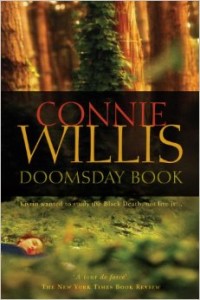Fun fact: the ‘doom’ in ‘doomsday book’ has little to do with the word ‘doom’ as in ‘gloom and doom’, but comes from the Latin ‘domus’ or house. I have to admit, though, that it sounds wonderfully creepy, which I suppose is the only reason Connie Willis chose it as the title to her novel as it has nothing to do with the early medieval document. It’s not even set in the same period of time.
The year is 2055, the place is Oxford. Historians have developed a time-travelling device and have been successfully sending people back to the 19th and 20th century using a device they call ‘the net’ which stops things that will radically alter history from going through. History student Kivrin, however, is fascinated by the middle ages and convinces her professors to send her to a small village named Skendgate so she can spend two weeks in the middle ages, recording her thoughts and observations. She is extensively prepared, learning Latin and old English (even though they spoke Middle English in the 1300s, but whatever) and skills like embroidery. Her immune system is enhanced and a recorder is implanted in her wrist, so she can pretend to pray while making observations. The organisation behind the time-travelling lab are quite enthusiastic, but one of her professors, a mr. …, still fears they are rushing into things. And rightly so; not long after Kivrin is beamed down, she falls terribly ill. Meanwhile, in Oxford, a mysterious epidemic grips the town and nobody is left to check on Kivrin’s whereabouts.
Doomsday Book is basically an intriguing idea with a middling execution. I didn’t care too much for it, though I find the Middle Ages to be fascinating and I do tend to like time travelling stories. The first problem is that, because the book was written in 1993 and the novel takes place at least partly in 2055, certain predictions about the future now look ludicrous. There are no mobile phones, for one; instead, everyone uses videophones, which marketeers have been trying to shove down our throats for nearly a decade now but which has never caught on. Frustratingly, the novel’s main problems would have been solved in a heartbeat if everyone had a mobile phone.
Then there are the characters, who simply don’t add up. Mrs. Gaddson, overbearing helicopter mother, reads like a robot’s failed attempt at humour derived from years of observations about the human race, and though she’s clearly meant to be comic relief she’s just irritating and fake enough that she asks for a suspension of disbelief in a time travelling novel. Then there’s Colin, who, judging from his dialogue, is only eight on some pages and at least sixteen on others (and he’s nowhere near a time machine). Mr. Gilchrist, the faculty dean, is a caricature of a spineless bureaucrat. And as for Kivrin, she’s so bland and average that I wonder why she, of all people, was sent to a century that, by their own admission, was very dangerous. Moreover, at the risk of sounding sexist: why would you send a girl alone into the thirteenth century, when women weren’t allowed to be alone, period? Why not some seven foot tall history nerd who does sword fighting for a hobby? Surely they must have had one of those around?
Then there’s the storyline, where obstacles keep being thrown up to postpone the big ‘climax’ (which you can, of course, see coming from miles away) until past the halfway point in the book, by which time I got more than a little frustrated with it. There is a lot of talk of bellringers and toilet paper and oatmeal and mufflers (apparently, everyone in Oxford in the 2050s uses that word instead of any of the more common alternatives) which is supposed to highlight the chaos of quarantine, where life continues on the one hand and doesn’t on the other, but instead is just detritus that stands in the way of a good story. Everything wraps up a little too conveniently, too, which makes sense if you think about the way in which time travelling works, but the book isn’t that smart so it feels like a cop-out.
It has its redeeming features, though. It’s always fascinating to get a glimpse of life in the Middle Ages and how familiar rituals such a Christmas mass were celebrated in those days, or what houses looked like, or how disease was dealt with. The side by side comparisons of epidemics in the 14th and 21st centuries, too, are interesting, but still could have been worked out better than they have here.
I recall someone else here read and reviewed this book and ended up loving it, so this may just be my snobby, nitpicky self, but to me Doomsday Book was a complete and utter miss.

